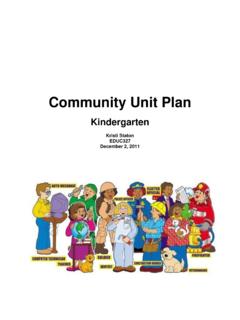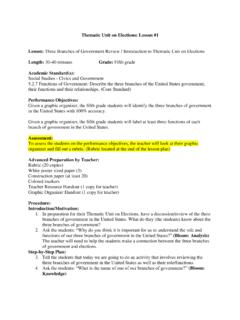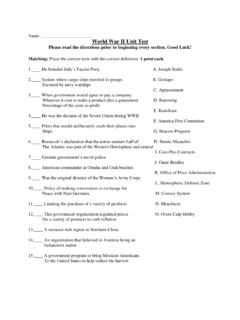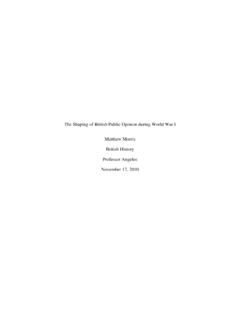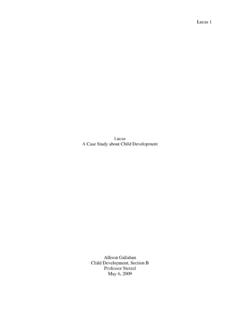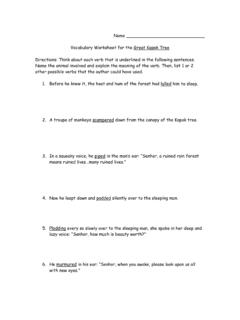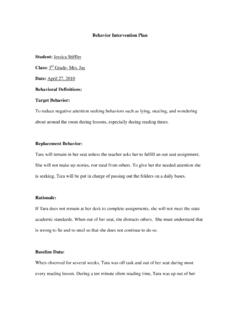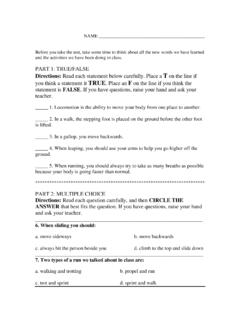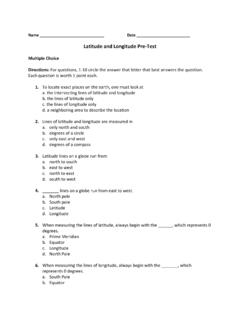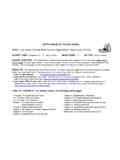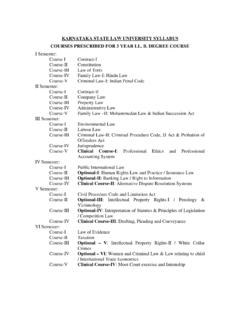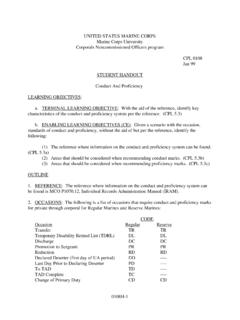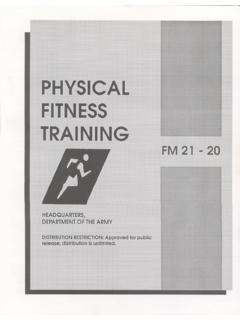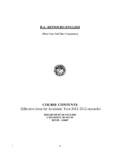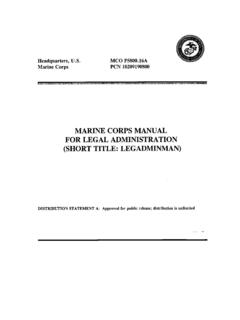Transcription of Community Thematic Unit Plan - Manchester …
1 Page | 1 Community Thematic unit plan 2nd Grade Allison Moore EDUC 327 December 11, 2009 Page | 2 Table of Contents Page Introductory 3 8 Curriculum 11 Letter to 12 Trade 14 Bulletin 16 Field trip/Guest 17 Technology and 18 Pre test/Post 19 Lesson 23 46 Page | 3 Introductory Sheet Grade level and typical learner: The grade level that is the focus on this Thematic unit plan is second grade. From the National Council for the Social Studies document titled Characteristics of Elementary Children and Social Studies, it talks about what a typical learner in second grade can do and what they should be learning about social studies. It says: Seven year olds become increasingly able to reason, listen to others, and show social give and take. Spatial relationships and time concepts are difficult for them to perceive.
2 Flexibility, open mindedness, and tolerance of unfamiliar ideas essential in social studies are formed to a remarkable extent by the interactions of the four to eight year olds (Joyce 1970). Eight year olds combine great curiosity with increased social interest. They are able to learn about people who live elsewhere in the world. During these early grades, children can learn from the symbolic experiences of reading books and listening to stories; however, their understanding of what they read is based on their ability to relate the written word to their own experience (NAEYC 1986). This said, there will be seven year olds and eight year olds combined in a second grade classroom. For seven year olds, they will show that they can listen to the teacher and other students as well as giving and taking information. They are very open minded and will adapt to unfamiliar ideas and try and learn more about them.
3 For eight year olds, their curiosity will have them wondering about different aspects as well as talking about the situation. They want to learn about people who live in China and what they do for fun or what they eat. Children this Page | 4 age want to learn about the people in social studies and the world around them, not just in their own town. They want to branch out and learn what it takes to be a good citizen and read books based on social studies themes. Rationale: Why do students need to participate in this unit of study? I believe that students need to participate in the study of communities to get a better understanding of how communities work and what they are. They will be learning about what it takes to keep a Community looking its best and how much effort goes into their Community . Explaining the different parts of one as well as learning about their own Community gives them a better understanding of where they live and what goes on in their own place.
4 Going to the local Community and showing them what their park looks like, or the people and business that make their Community different than others. I think that it will also help them learn about how different communities are but are alike in their own ways. There are many different celebrations and traditions that go on inside and out of communities. They should also learn more about how to help the Community that they live in, like picking up trash or recycling. Keeping the Community safe and environmentally friendly is very important because it shows that you know how to take care of your Community both environmentally and playing it safe. Goals: I want the students to learn more about the way a Community works. I want the students to learn more about how their Community works. I want the students to be able to list five or more pros about their own Community .
5 Page | 5 I want the students to be able to understand that being part of a Community is important and beneficial. I want the students to talk about the traits of being a good citizen. I want the students to be able to talk about different celebrations and traditions they have inside their Community . I want the students to be able to have an open discussion about different ways to help their Community (picking up trash, recycling, etc.) Learning Objectives Lesson One(Social Studies): After reading the book and discussing, the students will be able to identify responsibilities that individuals have to themselves and others 100% of the time. Given the instructions, the student will identify what makes a good citizen by describing four or more traits. Lesson Two(Writing): Given the materials, the students will describe four or more ways that people contribute to the Community .
6 Given the instructions, the students will use descriptive words when writing in every sentence. Lesson Three(Science): Page | 6 Given the celebrations in your Community , the student will explain by listing five ways they are important. Given the different roles people have, the student will identify four roles people have in families and communities. Lesson Four(Reading): Given the instructions, the students will identify what makes a good citizen by describing four or more traits. Given the story, the students will write down four or more facts that give into their comprehension of the story. Lesson Five(Math): Given the map, the students will find five places in their Community with objects to measure 100% of the time. Given an object, the students will measure an object to the correct measurement 8 out of 10 times (80%). Given an object, the students will choose the correct measurement 8 out of 10 times (80%).
7 Lesson Six(Drama): Given different traits for every student, the students will act out different roles in the Community through short stories with 100% accuracy Lesson Seven(Music): Page | 7 Give a map of the Community , the students will each sing one question a piece and call on someone to sing an answer back with 100% accuracy. Lesson Eight(Story telling): Given different consequences of violating laws, the students will tell stories with different approaches with 100% accuracy. Lesson Nine(PE Gross Motor): Given different places in their Community , the students will use their locomotor skills when called out while walking around the Community with 100% accuracy. Lesson Ten(Cooking): Given the ingredients for a pancake and the process, the student will label the different resources in the book with 80% accuracy (8 out of 10 correctly). Lesson Eleven(Art): Given the materials, they student will draw a time with their family or friends at a Community celebration complete with a small written explanation with 100% accuracy.
8 Lesson Twelve(PE Fine Motor): Given the materials, the student will perform manipulative skills correctly while showing ways that people do recreational activities with 100% accuracy. Page | 8 Standards Social Studies Lesson 1 In this lesson, the students will list traits that makes a good citizen by making charts and listing traits under: School Friends Community Home Social Studies Foundations of Government: Explain that the United States government is founded on the belief of equal rights for its citizens. Roles of Citizens: Identify people who are good citizens and describe the character traits that make them admirable. Writing Lesson 2 In this lesson, the students are going to talk about what they want to be when they grow up and the way they will make their Community beneficial in their composition notebooks. Then, the students can share their stories with the classroom if desired.
9 Social Studies Roles of Citizens: Describe how people of different ages, cultural backgrounds and traditions contribute to the Community and how all citizens can respect these differences. English Use descriptive words when writing. Science Lesson 3 In this lesson, the students are going to learn about the different types of roles that people have in a family and in a Community . For the activity, they will be making a collage from pictures and then drawing a picture of their family within their collage. Social Studies Identify and describe Community celebrations, symbols, and traditions and explain why they are important. Science Give examples of different roles people have in families and communities. Reading Lesson 4 In this lesson, the students will be talking about what their family does in their Community and the later they will be making a calendar of special events that happen around their Community .
10 They will also be looking up words in the Glossary in the back of the book and there will be a discussion about those words. Social Studies Roles of Citizens: Identify people who are good citizens and describe the character traits that make them admirable. English Identify the meaning of lesson of a story. Math Lesson 5 In this lesson, the students will be measuring things from around their Community . Different things will be brought in like street signs and sticks. They will also have an out of class assignment which will be done with the help of the parents. They will also be looking a map of the Community and looking at the physical Social Studies Physical Systems: On a map, identify physical features of the local Community . Mathematics Measure and estimate the length to the nearest inch, yard, centimeter, and meter. Describe which unit of length is most Page | 9 features.
